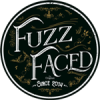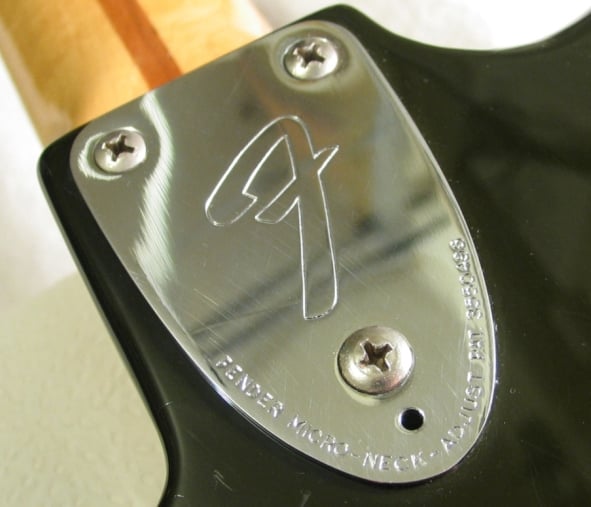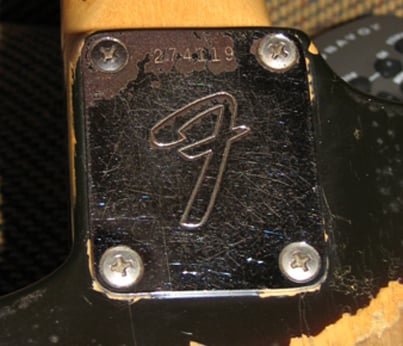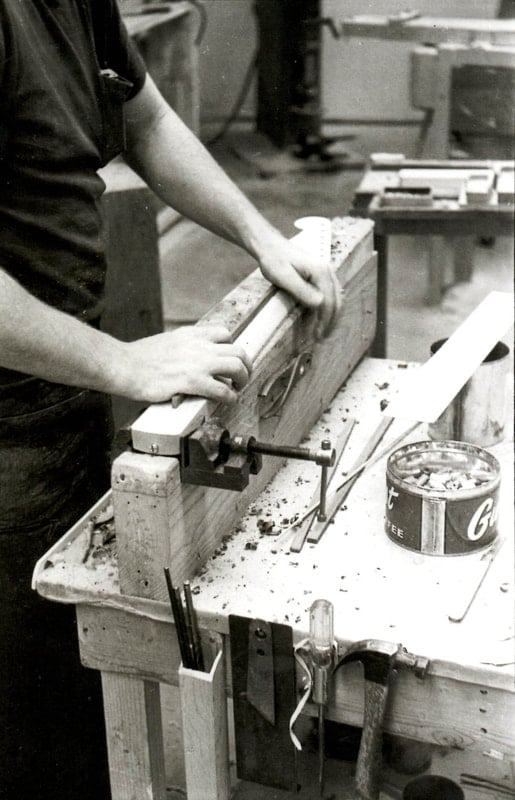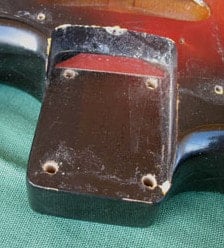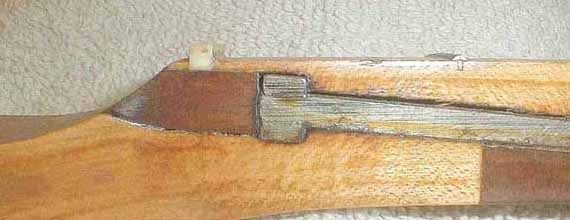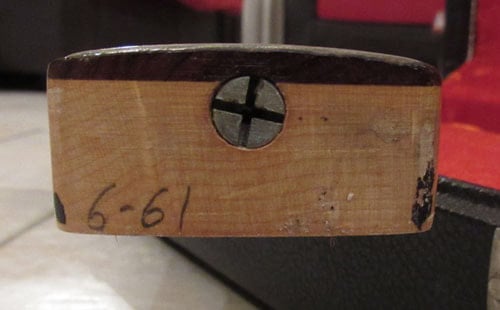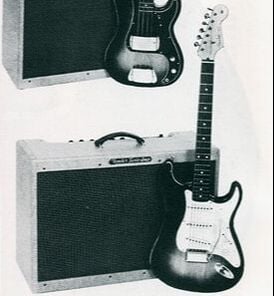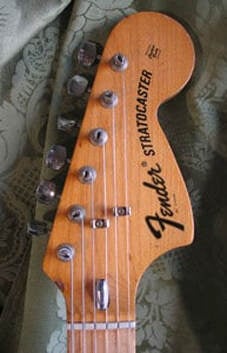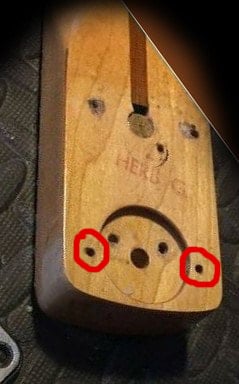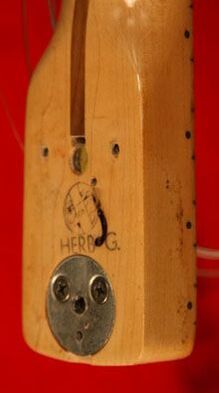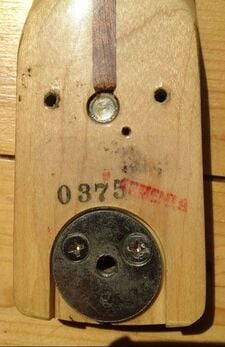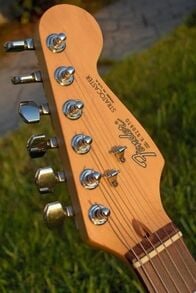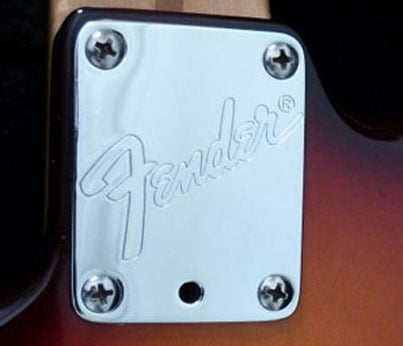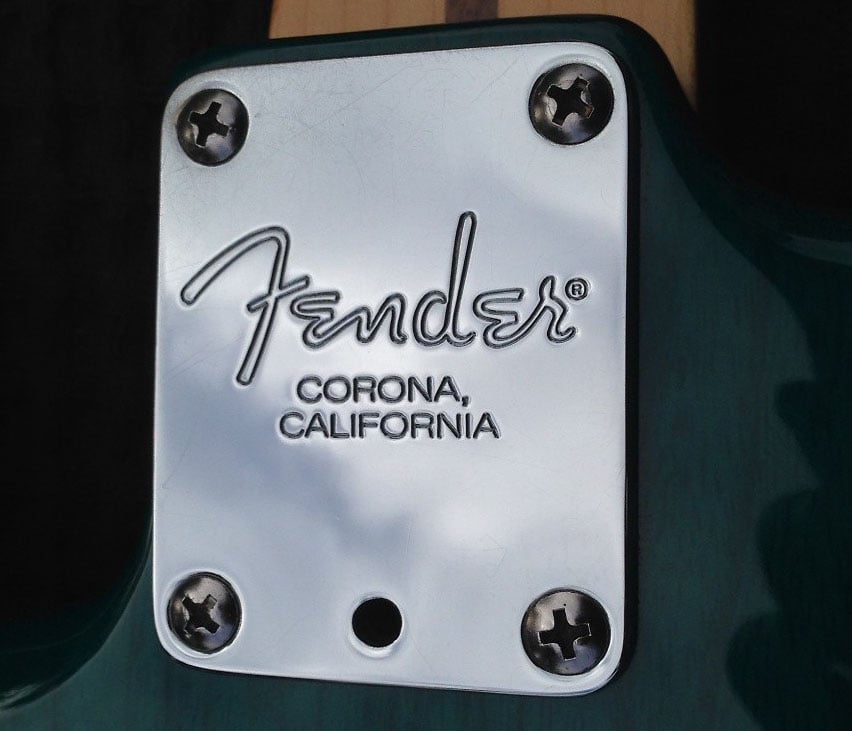NECK JOINT SYSTEM
|
There are three ways to attach a neck to a guitar: neck-through (or through-body), set-neck and bolt-on. Fender Stratocasters have almost always used a bolt-on neck attachment design, the most convenient to adjust, repair or replace. Neck is inserted in a pre-routed pocket in the body and joined using, until 1971, four screws (hence the name 4-bolt system). A rectangular metal plate (neck plate) is used to secure the joint and re-distribute the screw pressure. Although this system didn’t allow the same transmission of vibrations between the neck and the body as set-neck or neck-through systems did, it contributed to the Stratocaster's distinctive tone.
|
The first 4-bolt neck plates were plain. As early as June 1954, Fender started to stamp the serial number on the neck plate and, in mid-1965, a large "F" was added.
TRUSS ROD
|
The truss rod is a rod inserted into the neck to reinforce and to help keep it straight and true. All Stratocaster necks are fitted with a truss rod, but they do not share the same truss-rod installation and adjustment system.
The first Stratocaster's maple necks were fitted with a truss rod inserted from the rear via a channel routed in the back spine, subsequently filled with a strip of walnut. The characteristic look that this gave the neck of Fender guitars earned it the nickname skunk stripe. This also explains why these necks had a walnut plug above the nut (to fill the anchoring point of the rod). Thanks to the truss rod it was possible to adjust the curvature of the neck by a bolt located in the neck heel, whilst neck angle adjustment could only be achieved by inserting little shims in the neck pocket. The dimensions of the truss rod and its anchor nut have varied over time. Generally speaking, truss rods made until ’59 was longer than that of the guitars built in the following years. Fender truss rod wasn't made of stainless steel, but of zinc plated steel, and at first it wasn't wrapped in the plastic tube, which was added in 1966 when CBS re-designed the truss rod with a larger section. |
|
With the advent of a separate rosewood fretboard the truss-rod installation was modified, because it was easier to drill the rod channel in the neck prior to glueing the fretboard. This explains why rosewood-capped (and maple-capped) necks were devoid of the skunk stripe and of the walnut plug.
Contrary to many aftermarket necks, the truss rod bolt entered the rosewood slab-board on the original Fender necks. It's interesting to note that 1959-60 catalogues showed a rosewood-capped Stratocaster with a plug above the nut. Probably the truss-rod of this guitar, later owned by Gil Southworth, was still inserted from the rear and not from the front. In early 1970, the original one-piece fretted maple neck was reinstated as an option in lieu of the maple cap board on Stratocasters. |
By then, Fender would have had to deal with two methods of installation of the truss rod, from the front and from the rear. In order to optimize production, only the installation from the rear was retained, and this is why '70s rosewood-capped necks featured the skunk stripe.
BULLET TRUSS ROD
|
Few know that while Leo Fender worked as a consultant for the CBS, he, with the help of Freddie Tavares, came up with a new invention: the tiltable guitar neck incorporating thrust absorbing pivot and locking elements, also known as tilt-neck or micro tilt.
Thanks to the micro tilt the neck angle could be adjusted via a smaller wrench inserted into the lower hole below the screw of a 3-bolt neck plate. In addition to the serial number, the new neck plate was stamped with a huge “F” of Fender and the words “FENDER MICRO-NECK-ADJUST PAT. 3550496”. At the same time the truss-rod could be adjusted via a wrench inserted into a metal bullet located above the nut, without disassembling the neck, hence the name bullet truss rod. |
In late 1971 CBS replaced the neck shim and the 4-bolt neck plate respectively with the new micro tilt system and the 3-bolt neck plate.
The metal disk at the base of the neck was initially housed in a route which surrounded it perfectly. Since ca. 1976, the route was lengthened to reach the end of the neck.
Despite these changes, the truss-rod was still inserted from the rear and this explains the presence of the stripe.
The metal disk at the base of the neck was initially housed in a route which surrounded it perfectly. Since ca. 1976, the route was lengthened to reach the end of the neck.
Despite these changes, the truss-rod was still inserted from the rear and this explains the presence of the stripe.
In 1979, with the introduction of the 25th Anniversary Stratocaster, Fender came back to the vintage style truss rod and 4-bolt neck plate. The 1980 Strat, the Walnut Strat, and the mid-1981 Gold Stratocaster, as well as the late 1981 Standard Stratocaster (a.k.a. Smith Strat), were also fitted with the vintage style truss rod and the 4-bolt neck plate. And probably it was used also on a few 1981 "Sahara Taupe" (one of the International Color) finished Stratocasters.
BIFLEX TRUSS ROD
The new Bi-Flex Truss Rod was first introduced in mid-1983 on the Elite and the Standard Stratocaster (a.k.a. “2-Knob Stratocaster”). The neck angle could be adjusted in both concave and convex directions via a smaller wrench inserted into the truss rod adjustment hold placed at the nut. At the same time the micro-tilt was re-introduced, but this time with a 4-bolt neck plate.
'80S AND '90S NECK PLATES
The 1987 American Standard Stratocaster still featured the micro tilt and the 4-bolt neck plate, although it was stamped with the word “Fender” only. The same neck plate was also used on all the other US factory models (Strat Plus, Strat Plus Deluxe, Roadhouse Strat, Lone Star Strat, Big Apple Strat), except for the Strat Ultra, which had its own neck plate.
In 1998, the new American Deluxe Stratocaster featured a new neck plate stamped with “Fender CORONA, CALIFORNIA”. Since this moment on, all the left-over neck plates were used on the American Standard Strats, after which they were fitted with the same neck plate used on the American Deluxe Series.
In 1998, the new American Deluxe Stratocaster featured a new neck plate stamped with “Fender CORONA, CALIFORNIA”. Since this moment on, all the left-over neck plates were used on the American Standard Strats, after which they were fitted with the same neck plate used on the American Deluxe Series.
